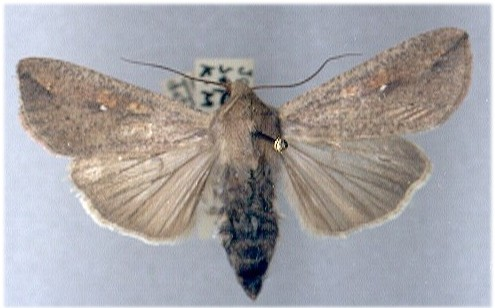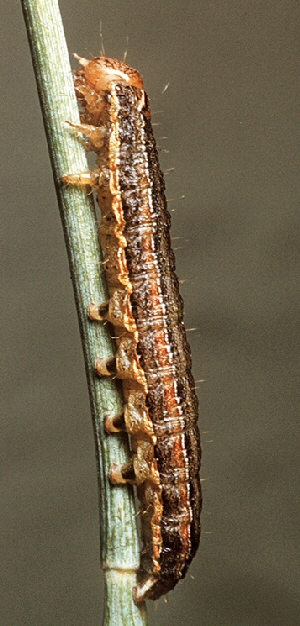Armyworm
 Scientific Name
Scientific Name
Pseudaletia unipuncta
Hosts
All common turfgrasses are susceptible but are less likely to be attacked than small grains, corn, timothy, millet, and some legumes. Armyworms are not typically a problem in established alfalfa, but seedling stands can be heavily damaged by their feeding.
Symptoms
Young caterpillars skeletonize the surface of leaf blades
and the inner surface of the sheaths. Older larvae begin feeding from the leaf edges and consume entire leaves. Extensive feeding can cause bare areas in lawns. Armyworms often invade grasses in wet areas and may become most abundant after flooding has occurred. Plants that have lodged to make a dense canopy are often infested with the highest numbers. This species is a true armyworm; the larvae may migrate en masse from a decimated area to enter an area of abundant food supply. Damage to lawns is normally found only in years when this species is especially abundant in wheat and other small grains. Only the first generation (during May) and the fourth generation (during September) are likely to damage turfgrasses in Oklahoma. In years when the first generation of larvae have been^ present in wheat, homeowners often will find the adult moths ("millers") in large numbers hiding in shrubs and trees in early summer.
Life Cycle
Armyworms overwinter as pupae or as mature larvae which pupate in the spring. Moths emerge in the spring, mate, and lay eggs in masses on hosts plants (mostly in the grass family). Larvae feed for about 4 weeks but do most of their damage during the last 10 days of this period. They then pupate in cells in the soil. A new generation of moths emerges about 1 week later. There are 4 generations per year in Oklahoma.
Description
The adult moth is uniformly pale brown to grayish brown in color, with a wingspread of about 1 1/2 inches. There is a characteristic small, white spot near the center of each front wing. The eggs are greenish white and spherical and are laid in masses. Mature larvae are about 1 1/2 inches long with a yellowish or grayish ground color, more or less tinged with pink. The dorsum is greenish brown to black with a narrow, broken, light median stripe. A dark stripe on each side includes the black spiracles in its lower edge. The subspiracular stripe is pale orange, mottled, and edged with white.
Control
Management of armyworms is varies depending on the crop type. For turfgrasses, see the Fall Armyworm information provided on the Turfgrass Science webpage.
Alfalfa producers should review CR-7150, “Alfalfa Forage Insect Control” for additional information about armyworms and other foliage feeding caterpillars in alfalfa.
Small grain producers can find information about armyworms in EPP-7094 “Common Small Grain Caterpillars in Oklahoma”.
Please contact your local county extension office for current information.


